Browser
The Browser gives access to Guitar Rig's library, including presets and Components. Favorites, Filters, and the Search field enable you to quickly find the right content.
The Browser gives access to Guitar Rig's extensive library, including presets and Components. Sophisticated browser functionality like Favorites, Filters, and the Search field enable you to quickly find the right content.
The following overview shows you the basic structure of the Browser:
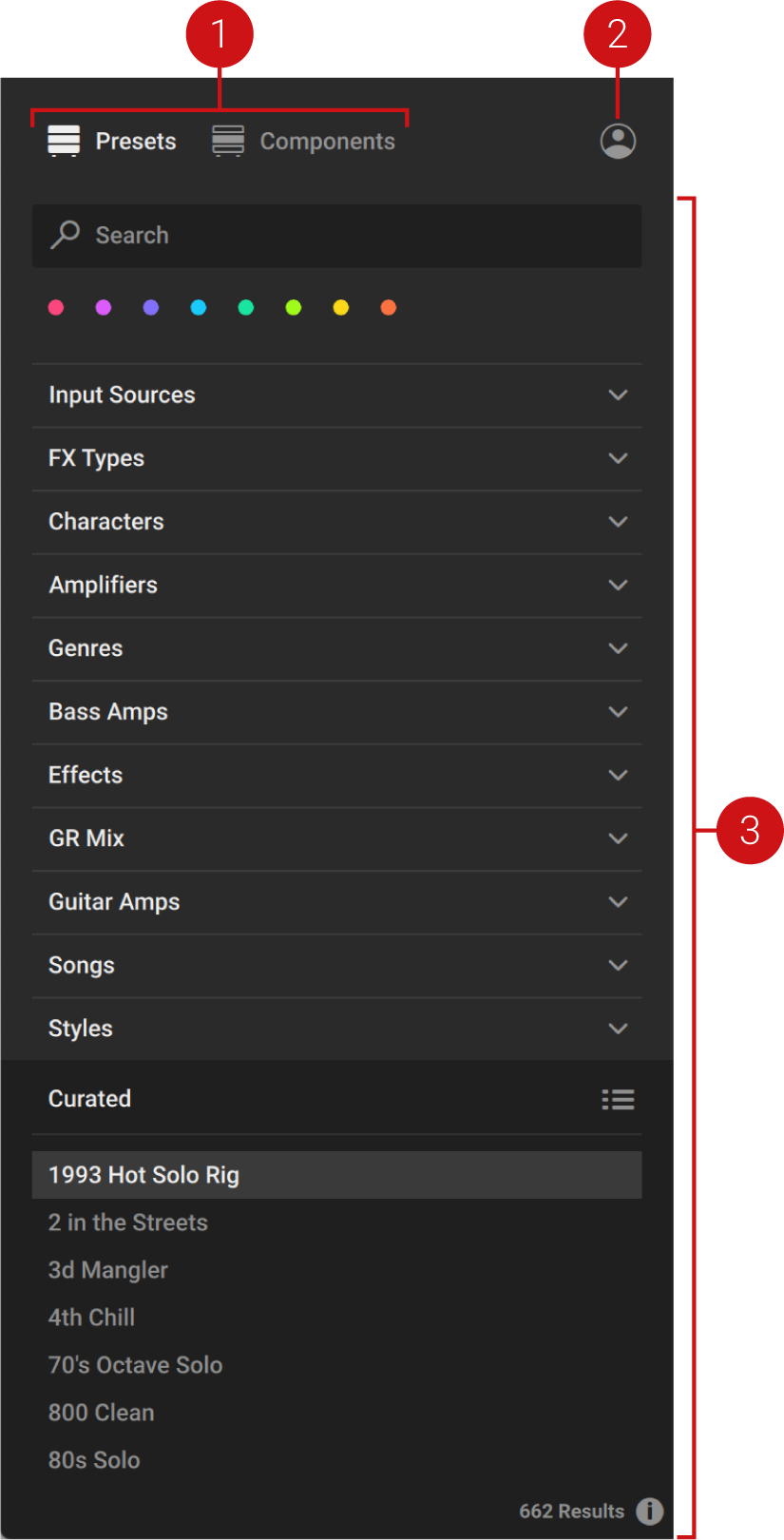 |
Content selector: Selects the type of content to be shown in the Browser interface. The following types of content are available in Guitar Rig:
Presets: A Preset recalls a previously saved Rack including its Components, all individual parameter settings, and the options set in the Toolbar. For more information about the Browser interface for presets, refer to Presets in the Browser.
Components: A Component represents an individual effect that can be added to a Rack. Component presets recall previously saved parameter settings for specific Components. For more information about the Browser interface for Components, refer to Components in the Browser.
User Content: Filters by user content. When activated, the Browser interface only shows content created by the user. If the Content selector is set to Presets, only User presets are shown in the Results list. If the Content selector is set to Components, only Components that have associated User Component presets are shown in the Component Tiles. When deactivated, the Browser interface shows both library and user content.
Browser interface: Shows the content selected using the Content selector. The elements in the Browser user interface adapt to the type of content, in order to facilitate the best possible browsing experience:
When Presets is selected, you can use the Search field, Favorites, Filters, and Results list to filter and browse for presets.
When Components is selected, you can use the Category Filter, Component Tiles, and the Component preset list to filter and browse for Components and their dedicated Component presets.
Presets in the Browser
The following overview shows you all the elements in the Browser that you can use to explore Guitar Rig's extensive library of presets:
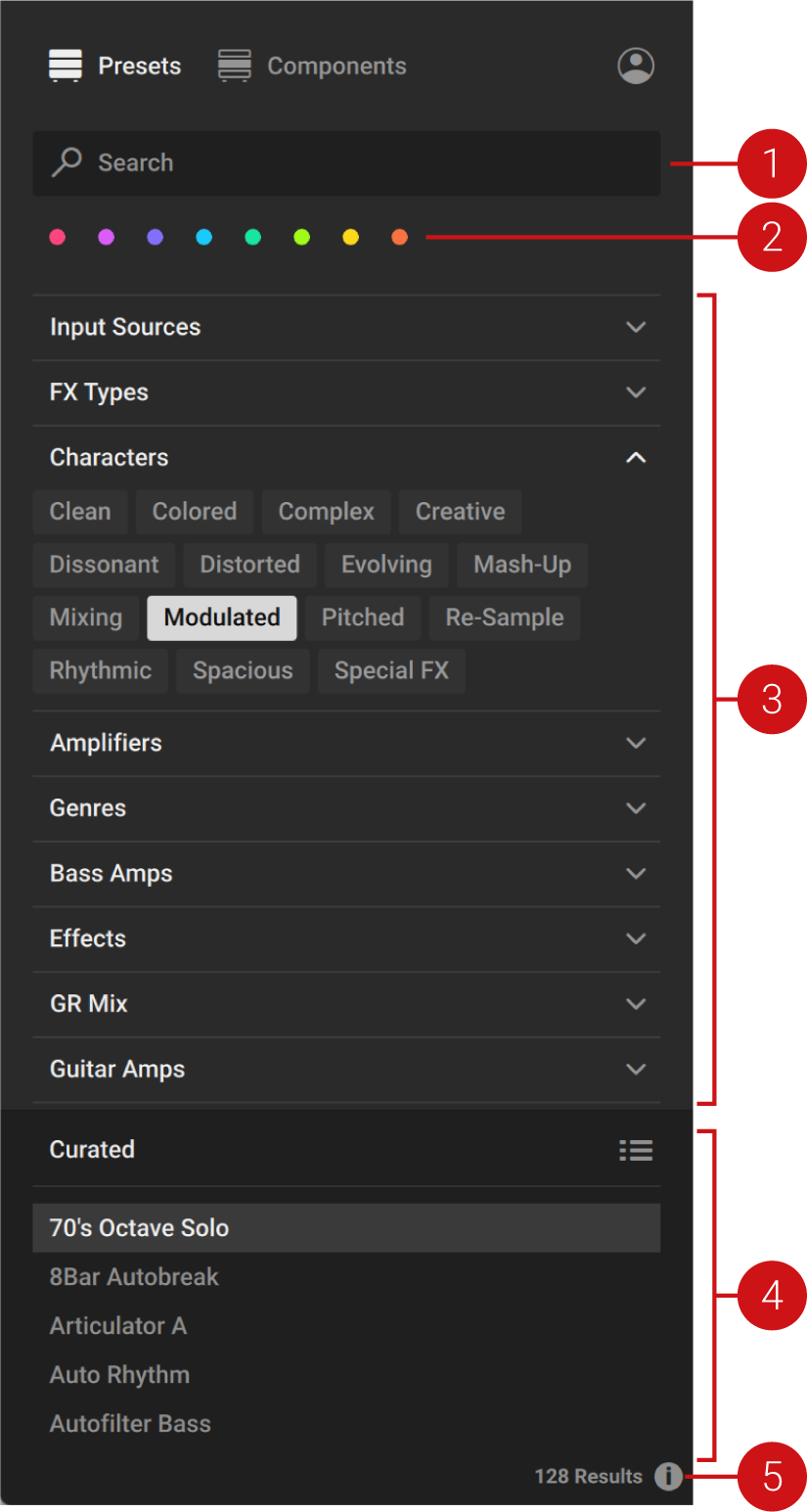 |
Search field: Finds presets matching the terms entered in the field and shows them in the Results list. For more information, refer to Using the Search Field.
Favorites: Filter the presets in the Results list by colored Favorite tags that you can use to create collections of your favorite presets. You can assign Favorite tags by using the context menu in the Results list. For more information, refer to Using Favorites.
Filters: Filter the presets in the Results list by Filter tags that are used to characterize and classify presets. The Filter tags are organized in groups of different Filter types. For more information, refer to Using Filters.
Results list: Shows presets according to the options set in the Search field, Favorites, and Filters. The Sorting options at the top provide different options for changing the order of presets. For more information, refer to Sorting the Results list.
Info pane: Opens the Info pane that you can use to view the Filter tags and properties of each preset. Additionally, the Info pane enables you to edit the Filter tags and properties for User presets, and add your own User Filter tags. For more information, refer to Editing User Presets in the Info Pane.
Components in the Browser
The following overview shows you all the elements in the Browser that you can use to explore Guitar Rig's extensive library of Components:
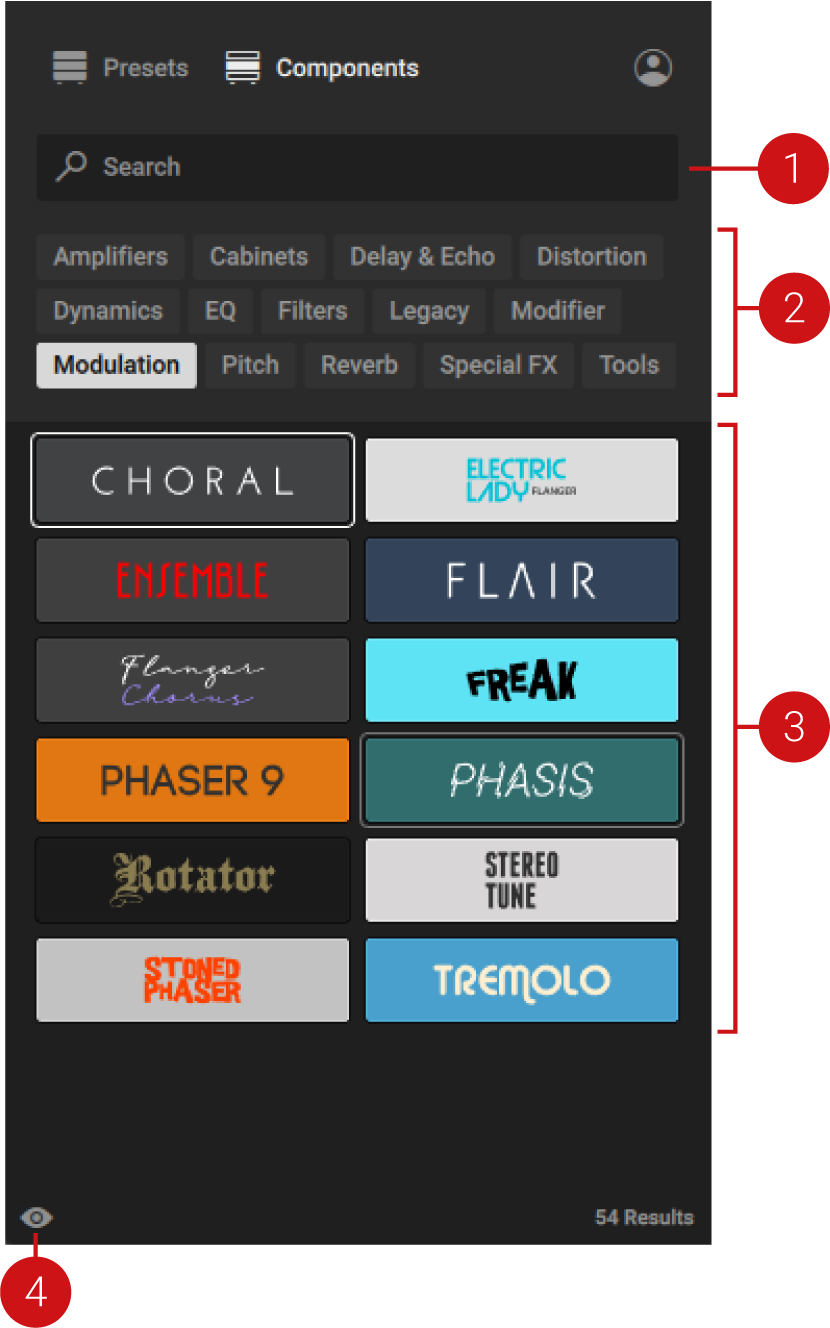 |
Search field: Finds Components matching the terms entered in the field and shows them in the Component Tiles. For more information, refer to Using the Search Field.
Category Filter: Filters the Component Tiles by Filter tags that are used to categorize the Components. For more information, refer to Using Filters.
Component Tiles: Represent the individual effects available in Guitar Rig, called Components. You can use the Component Tiles to browse for Components and add them to your Rack. For more information, refer to Adding Components to the Rack.
Tip
You can pin Components at the top of the Component Tiles for easy access. For more information, refer to Pinning Components.
Show Component presets: Shows the dedicated presets for the Component selected in the Component Tiles. For more information, refer to Using Component Presets.
Using the Browser
The Browser gives access to Guitar Rig's extensive library by enabling you to quickly find a specific preset or Component, as well as explore groups of presets or Components based on your aesthetic and stylistic preferences.
Utilizing the concept of progressive disclosure, each element in the Browser interface contributes to a fluent workflow that continuously filters the Results list or Component Tiles in a meaningful way.
When browsing for presets, you can combine the Search field, Favorites, and Filters to narrow down the presets in the Results list. When browsing for Components, you can combine the Search field and Category Filter to narrow down the Component Tiles.
The following sections explain how to use each of the individual elements in the Browser interface, including the Search field, Favorites, Filters, and the Sorting options of the Results list.
Using Filters
The Filters enable you to filter presets or Components by Filter tags. These tags are used to characterize and classify presets based on their sound, use case, and other attributes. Components are tagged according to categories of effects. All presets and Components in the Guitar Rig library are tagged in a meaningful way so you can start browsing right away.
When browsing for presets, the Filter tags are organized in groups of different Filter types. When browsing for Components, the Filter tags are organized in the single Category Filter.
Tip
You can also assign Filter tags to your own User presets. For more information, refer to Editing User Presets in the Info Pane.
Using Filters for Presets
To filter the presets in the Results list using Filter tags from multiple Filter types:
Click a Filter type to open it and show the contained Filter tags.
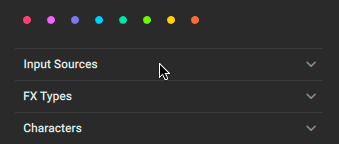
Click a Filter tag to start filtering the presets in the Results list.

Click another Filter type to open it and show the contained Filter tags. The other Filter types will be closed automatically.
Note
To show Filter tags for multiple Filter types at the same time, press [command] (macOS) or [Ctrl] (Windows) + click to open them.
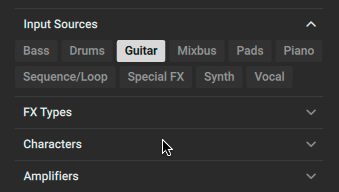
Click a Filter tag to continue filtering the presets in the Results list.
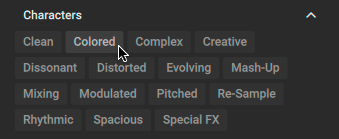
Press [command] (macOS) or [Ctrl] (Windows) + click to select another Filter tag from the same Filter type and further filter the presets in the Results list.
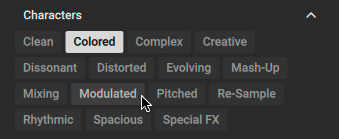
The presets in the Results list are filtered by the selected Filter tags. Only presets carrying all of the selected Filter tags are shown.
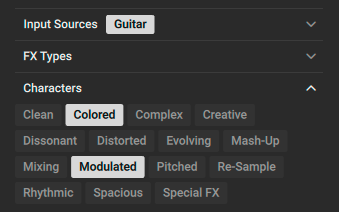
Using the Category Filter for Components
To filter Component Tiles using the Category Filter:
Click a Filter tag to start filtering the Components Tiles.
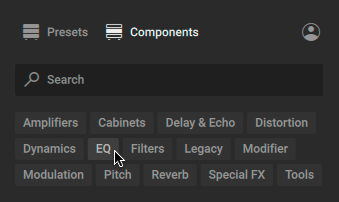
Press [command] (macOS) or [Ctrl] (Windows) + click to select another Filter tag and add Component Tiles from the respective category.

The Component Tiles are filtered by the selected Filter tags. All Components in any of the selected categories are shown.

Sorting the Results list
The Results list provides different Sorting options that you can use to change the order of presets in the Results list.
To change the order of presets:
Click the area at the top of the Results list to show the Sorting options.
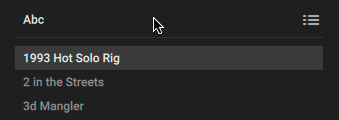
Click on one of the options to select it.
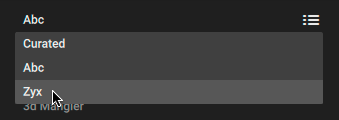
The presets in the Results list are sorted according to the selected option.
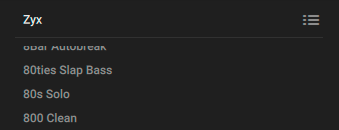
The following Sorting options are available:
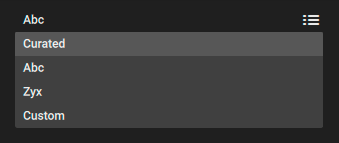
Curated: Sorts the Results list in the order curated by the sound designers.
Abc: Sorts the Results list in alphabetical order.
Zyx: Sorts the Results list in reverse alphabetical order.
Custom: Sorts the Results list in the custom order set for Favorites. For more information, refer to Sorting Favorites in the Results List.
Using the Search Field
The Search field at the top of the Browser interface enables you to find presets or Components matching the terms entered in the field and shows them in the Results list.
When Presets is selected in the Content selector, the search considers preset titles and metadata, including Filter tags and the author.
When Components is selected in the Content selector, the search considers Component titles, Category Filters, and the associated Component presets.
To find presets or Components using the Search field:
Activate the Search field by clicking it.

Enter your search terms.

The Results list or Component Tiles are filtered according to the terms entered in the Search field.
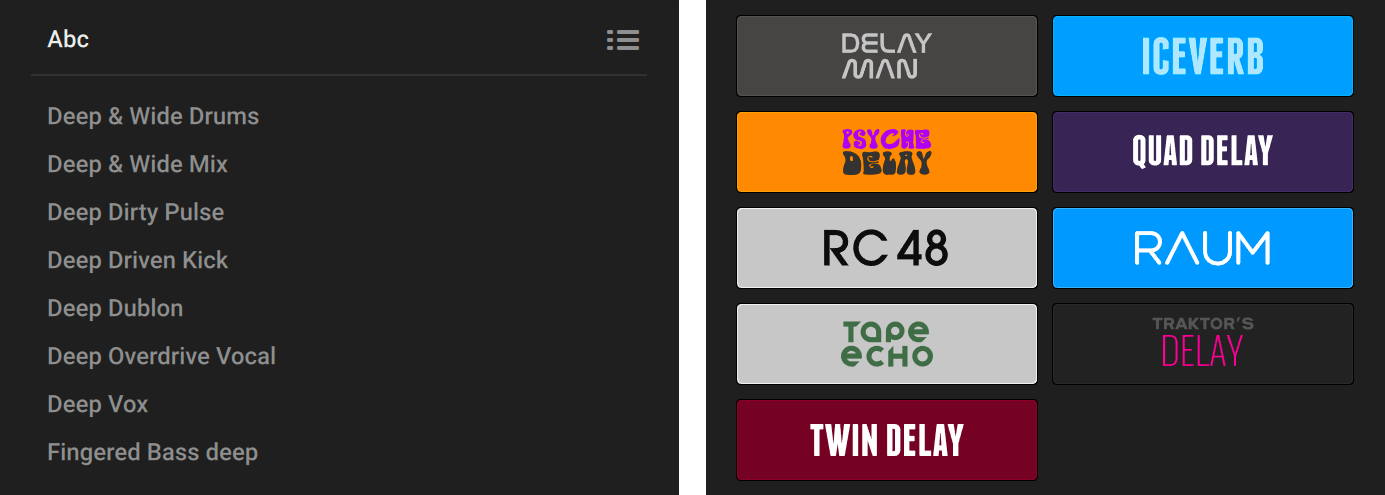
Using Favorites
The Favorites enable you to filter the presets shown in the Results list by colored Favorite tags. By assigning these tags to your favorite presets, you can create your personal preset collections and quickly access them.
Assigning a Favorite Tag
To assign a Favorite tag:
Right-click a preset in the Results list to open the context menu. If multiple User presets are selected, the changes will apply to all of them.
Note
You can select a preset by clicking on it. Holding [SHIFT] on the keyboard allows for selection of multiple presets.
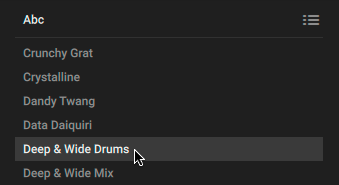
Select one of the colored Favorite tags from the context menu.
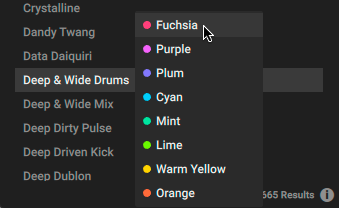
The selected Favorite tag is assigned to the preset and shown as a colored dot next to preset title.

Removing a Favorite Tag
To remove an already assigned Favorite tag from a preset:
Click on the corresponding entry in the context menu. If multiple User presets are selected, the changes will apply to all of them.

The favorite tag is removed from all selected presets.
Filtering the Results List by Favorites
To filter the presets shown in the Results list by your previously assigned Favorite tags:
Click a tag in the Favorites to select it.

The Results list is filtered according to your selection and only shows presets that have been assigned the respective Favorite tag.
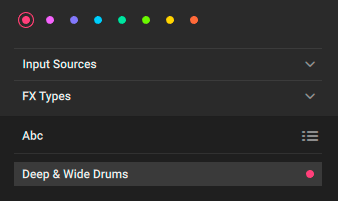
Tip
Favorites shown in the Results list can be sorted in a custom order set by the user. For more information, refer to Sorting Favorites in the Results List.
Sorting Favorites in the Results List
Favorites in the Results list can be sorted in a custom order set by the user. You can set a custom order for each of the eight Favorite tags available in the Browser. Each Favorite tag retains the last selected Sorting option. When switching between Favorite tags, the Sorting options change accordingly.
To sort the Favorites in the Results list:
Click a Favorites tag to show the corresponding presets in the Results list.

Select Custom in the Sorting options of the Results list.
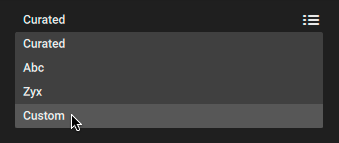
Click, drag, and drop any of the presets into a new position in the Results list.

The Favorites in the Results list are sorted in your new custom order.
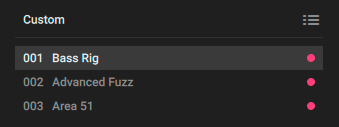
Note
You can recall this custom order at any time by selecting Custom in the Sorting options when a Favorite tag is selected in the Browser. For more information, refer to Sorting the Results list.
Pinning Components
You can pin your favorite Components at the top of the Component Tiles for easy access.
To pin a Component, place the mouse over the Component you want to pin and click the pin icon that appears.

The Component is pinned at the top of the Component Tiles. You can unpin it by clicking on the pin icon again.
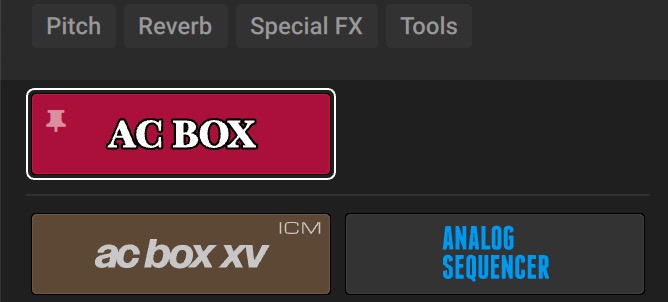
Using Presets
A preset recalls a previously saved Rack including its Components, all individual parameter settings, and the options set in the Toolbar. In addition to the presets included in Guitar Rig's extensive library, you can save, load, and import User presets. Furthermore Component presets enable you to save settings of individual Components. The following sections explain the basic workflows involved in using presets.
Loading Presets
You can load presets directly from the Browser's Results list.
To load a preset, double-click on the corresponding entry in the Results list.

Tip
Alternatively, you can select the entry in the Results list using the mouse or the arrow keys on the keyboard and press [enter] to load a preset. For more information, refer to Keyboard Shortcuts.
You can also use the Rack's Toolbar to load presets. The following overview shows you the available controls:
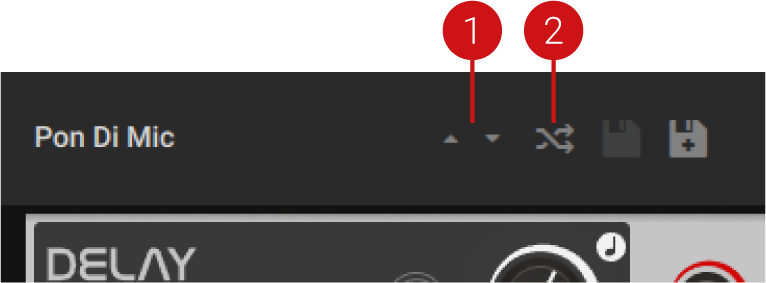 |
Previous preset / Next preset: Switches between presets in the Browser's Results list. Clicking on the upwards arrow loads the previous preset. Clicking on the downwards arrow loads the next preset.
Preset Shuffle: Loads a random preset from the Browser's Results list.
Note
The Search field, Favorites, and Filters in the Browser enable you to narrow down the presets in the Results list. For more information, refer to Using the Browser.
Saving User Presets
You can save User presets directly in the Rack's Toolbar.
Saving a New User Preset
To save a new User preset:
Click the Save new preset button in the Toolbar.

Type in a name for your User preset and confirm by clicking OK.
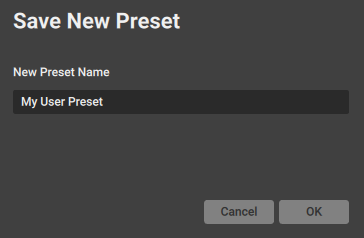
The User preset is saved and a new entry is added to the Results list, highlighted by the USER label.
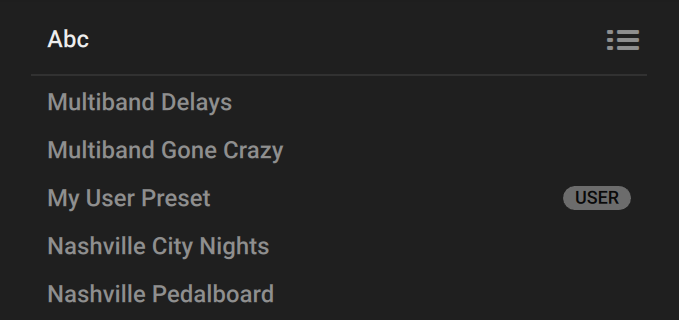
Tip
Alternatively, you can press [command] + [shift] + [S] (macOS) or [Ctrl] + [Shift] + [S] (Windows) on the keyboard, or use the command from the Main menu. For more information, refer to Managing Presets Using the Main Menu.
Tip
To quickly find your User presets, you can filter the Browser's Results list by User presets. For more information, Browser.
Saving Changes in a User Preset
To save changes made in a User preset:
Click the Save preset button in the Toolbar.

Tip
Alternatively, you can press [command] + [S] (macOS) or [Ctrl] + [S] (Windows) on the keyboard, or use the command from the Main menu. For more information, refer to Managing Presets Using the Main Menu.
Importing User Presets
You can import User presets from the hard drive. User presets are saved in the following folder:
macOS: Macintosh HD/Users/<user name>/Documents/Native Instruments/User Content/Guitar Rig <version number>/Rack Presets
Windows: C:\Users\<user name>\Documents\Native Instruments\User Content\Guitar Rig <version number>\Rack Presets\
To import a User preset:
Open the Main menu in the Header and select Import... in the File sub-menu.

Navigate to the preset file you want to import, select it, and confirm by clicking Open.
The User preset is imported and can be accessed in the Browser.
Note
You can also import all User presets from an existing Guitar Rig installation at the same time using the option in the Preferences. For more information, refer to Library.
Editing User Presets in the Info Pane
You can use the Browser's Info pane to edit the Filter tags and properties for User presets.
To open the Info pane for a User preset, select the User preset and click the Info Pane button in the Browser.

The following overview shows the Filter tags and properties you can edit in the Info pane:
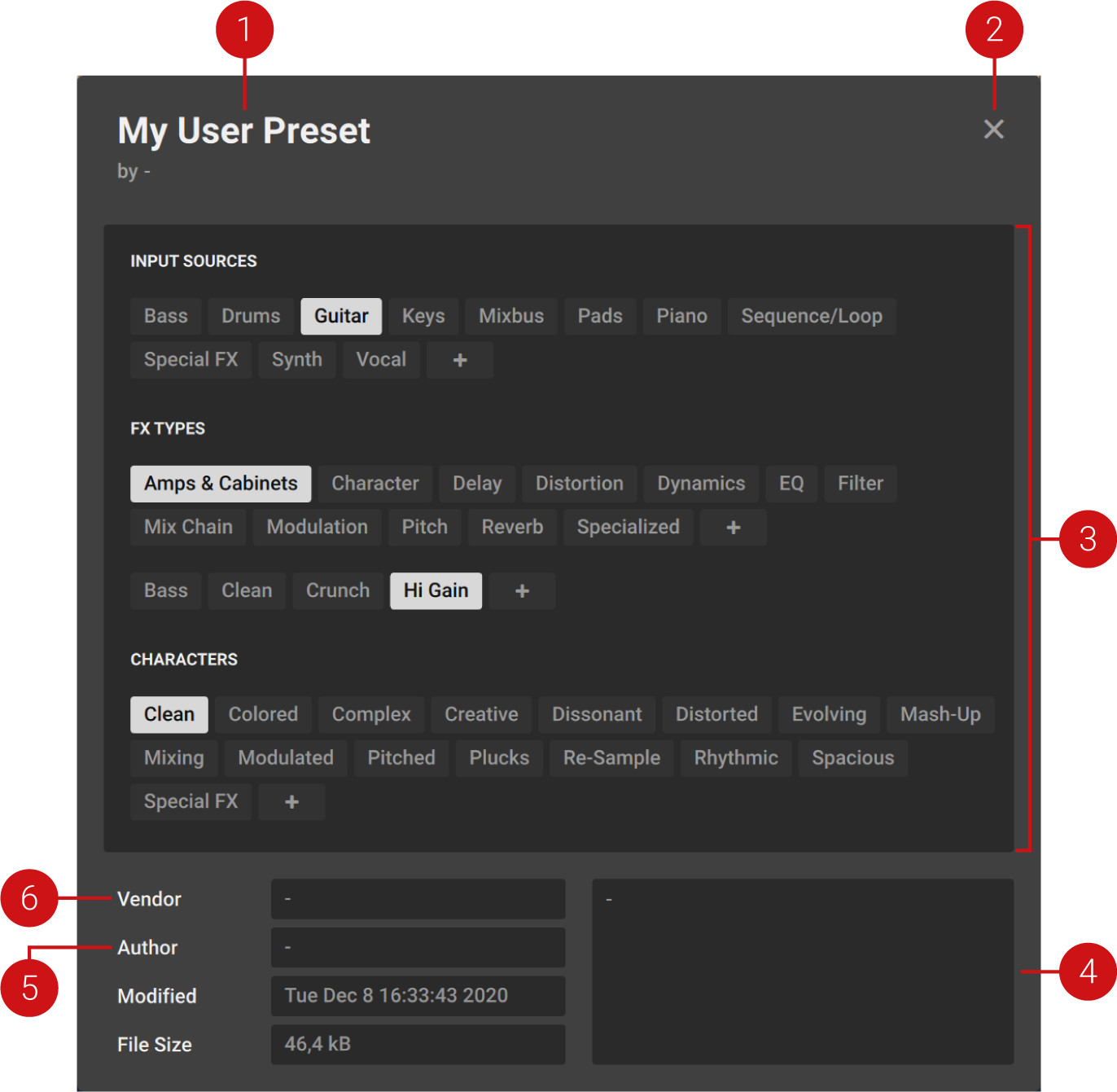 |
Preset name: Displays the name of the User preset. When placing the mouse over the name, a pen icon appears next to it that you can click to change the name. Alternatively, you can double-click the name to change it.
Close Info pane: Closes the Info pane.
Filter tags: Displays all available Filter tags. You can assign Filter tags to your User preset by selecting them. Furthermore, you can add and assign your own User Filter tags. For more information, refer to Managing User Filter Tags.
Comment: Displays the comment associated with the User preset. You can click in the field to change the comment.
Author: Displays the name of the author associated with the User preset. You can click in the field to change the name.
Vendor: Displays the name of the vendor associated with the User preset. You can click in the field to change the name.
Managing User Filter Tags
You can add your own User Filter tags and assign them to a User preset in the Info Pane of the Browser.
Adding a User Filter Tag
To add a User Filter tag:
Select the User preset you want to assign your own User Filter tag to in the Results list by clicking on the corresponding entry.

Click the Info Pane button in the bottom right corner of the Results list to open the Info pane.

Click on the + icon under the Filter type you want to add your User Filter tag to.

Type in a name for your User Filter tag.

Press [Enter] or click anywhere in the Info pane to confirm the name and save your User Filter tag.
Your new User Filter tag is added and assigned to the User preset.

Note
Once added, your User Filter tag shows up in the Browser and can be used to filter the presets in the Results list. For more information, refer to Using Filters.
Deleting a User Filter Tag
To delete a User Filter tag from the Browser:
Filter the presets in the Results list by clicking on the User Filter tag you want to delete.
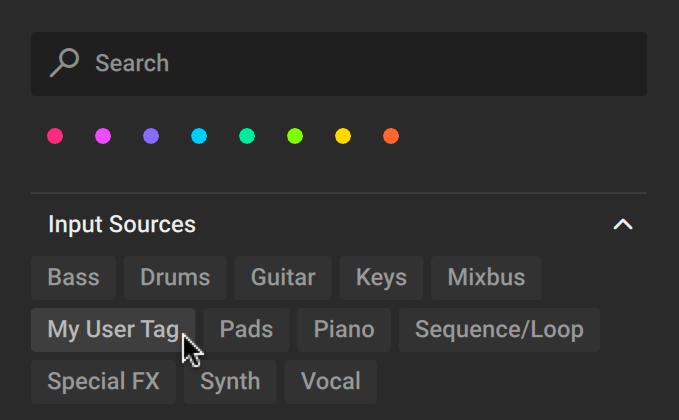
Select a User preset in the Results list by clicking on the corresponding entry.

Click the Info Pane button in the bottom right corner of the Results list to open the Info pane.

In the Info pane, click on the User Filter tag you want to delete in order to remove it from the selected User preset.

Repeat steps 2 and 4 for all User presets the User Filter tag is assigned to.
The User Filter tag is deleted and does not show up in the Browser any more.
Deleting User Presets
You can delete User presets directly in the Browser. The entries will be removed from the Results list, and the corresponding files will be deleted from the User folder.
To delete User presets:
Right-click a User preset in the Results list to open the context menu. If multiple User presets are selected, the changes will apply to all of them.
Note
You can select a preset by clicking on it. Holding [SHIFT] on the keyboard allows for selection of multiple presets.

Select Delete Preset from the context menu.
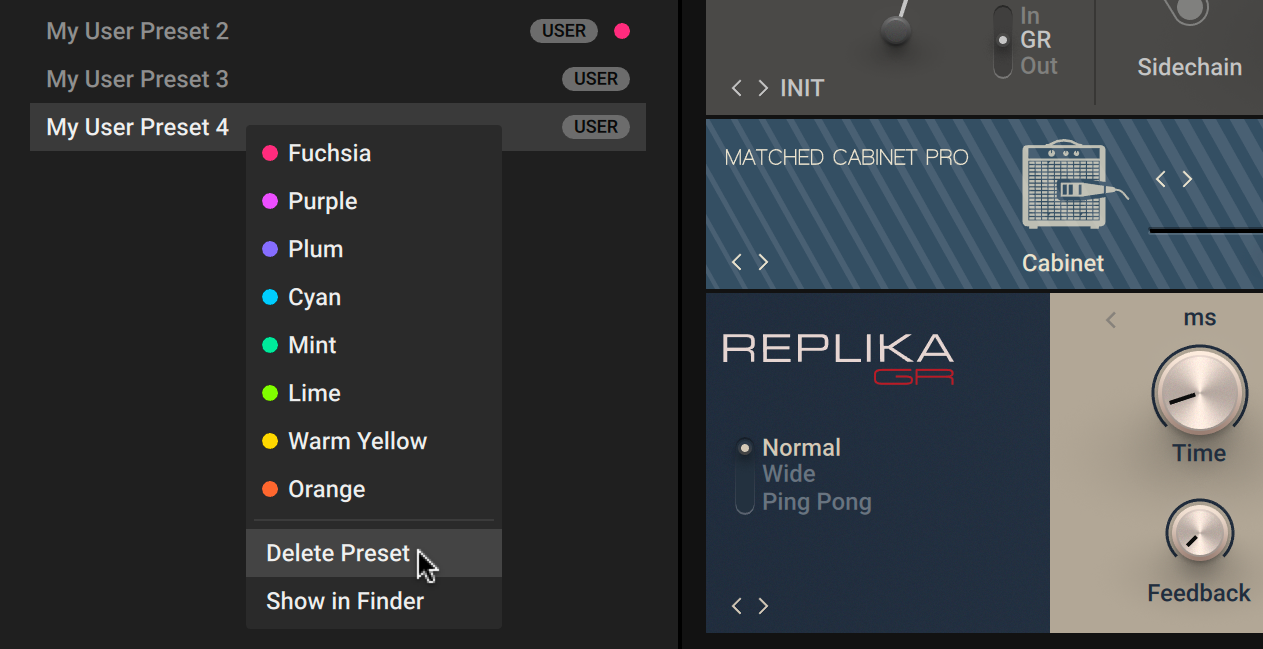
Confirm that you want to delete your User preset by clicking Delete in the dialog box.
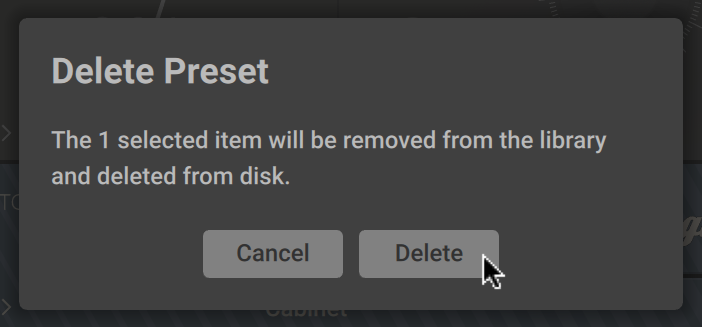
The User preset is deleted from the hard drive and does not show up in the Results list any more.
Tip
For more information about the User folder, refer to Importing User Presets.
Using Component Presets
Component presets contain all settings of a Component, enabling you to save and recall the state of a Component independently of the Rack. You can load Component presets from the Guitar Rig library to quickly try new settings, or save your personal settings for later use. You can access Component presets in the Browser or in the Component itself.
Component Presets in the Browser
You can access Component presets in the Browser when the Component selector at the top is set to Components. Using the Results list, you can browse for and load Component presets. Additionally, you can delete User Component presets that you have previously saved using the Component's Preset menu.
To show the Component presets in the Results list, click the View Component Presets button in the bottom left corner of the Browser.
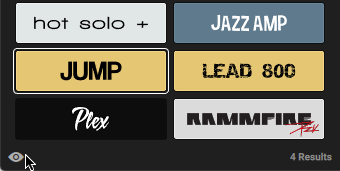
You can load a Component preset using drag and drop. The associated Component is added automatically.
Drag and drop the Component preset from the Results list into the Rack. The expected position of the added Component is indicated by a yellow line.

Note
You can also replace one or multiple Components by loading a Component preset in the same way Components can be replaced with a Component. For more information, refer to Replacing Components in the Rack.
You can delete User Component presets using the context menu in the Results list.
To delete User Component presets, right-click on the respective entry in the Results list and select Delete Preset.

Component Presets in the Component
You can access Component presets in the Component by using the Preset menu, which also enables you to save your own User Component presets.
To show the Preset menu in a Component, click on the preset name shown in the interface.
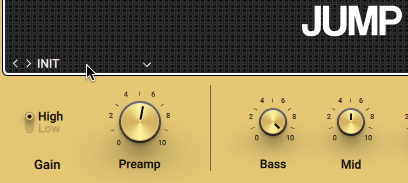
The following overview shows the available options in the Preset menu:
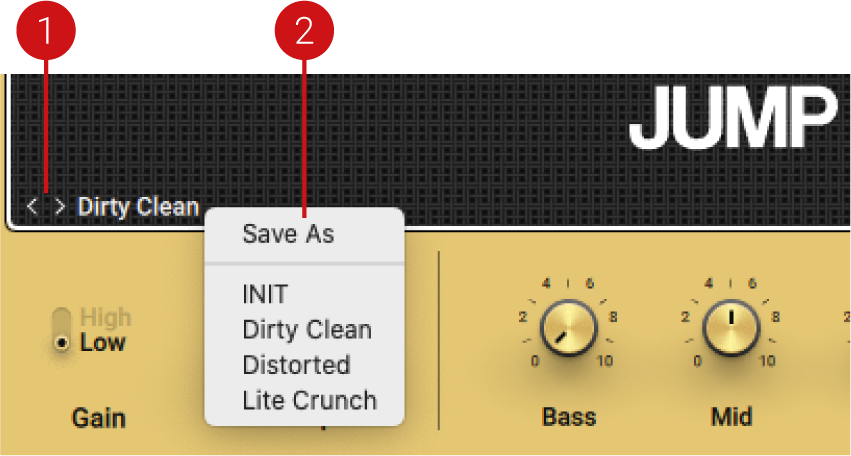 |
Previous preset / Next preset: Switches between Component presets of the respective Component. Clicking on the leftward arrow loads the previous preset. Clicking on the rightward arrow loads the next preset.
Drop-down menu: Provides the Save As option to save a new User Component preset, and shows a list of all available Component presets. Clicking on an entry in the list loads the corresponding Component preset.
Saving the INIT Preset
By saving a User Component preset with the name "INIT" you can set the default state of the Component. The INIT User Component preset will be loaded automatically when the Component is added to the Rack. If there is no INIT User Component preset, the INIT Factory preset will be loaded instead.
